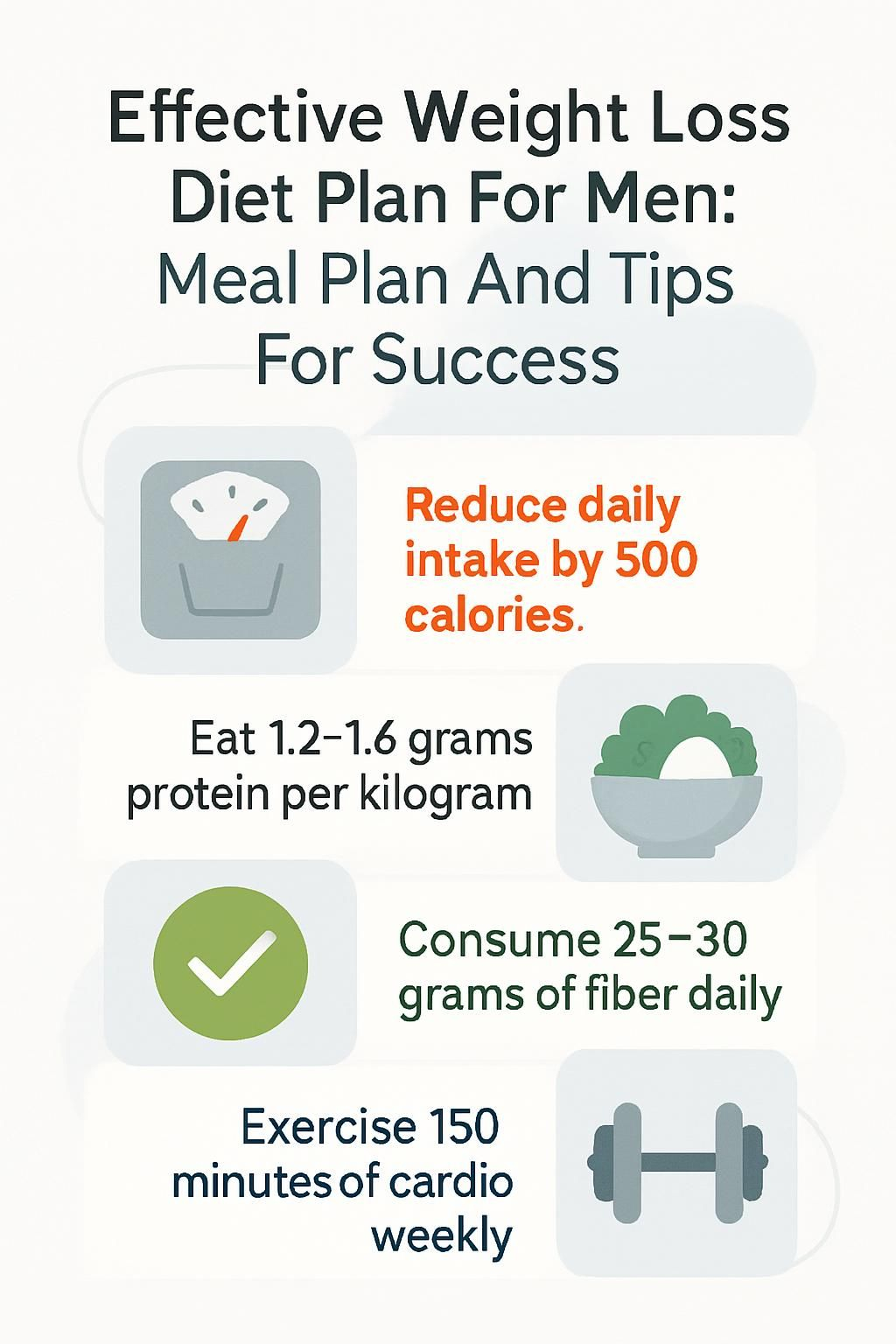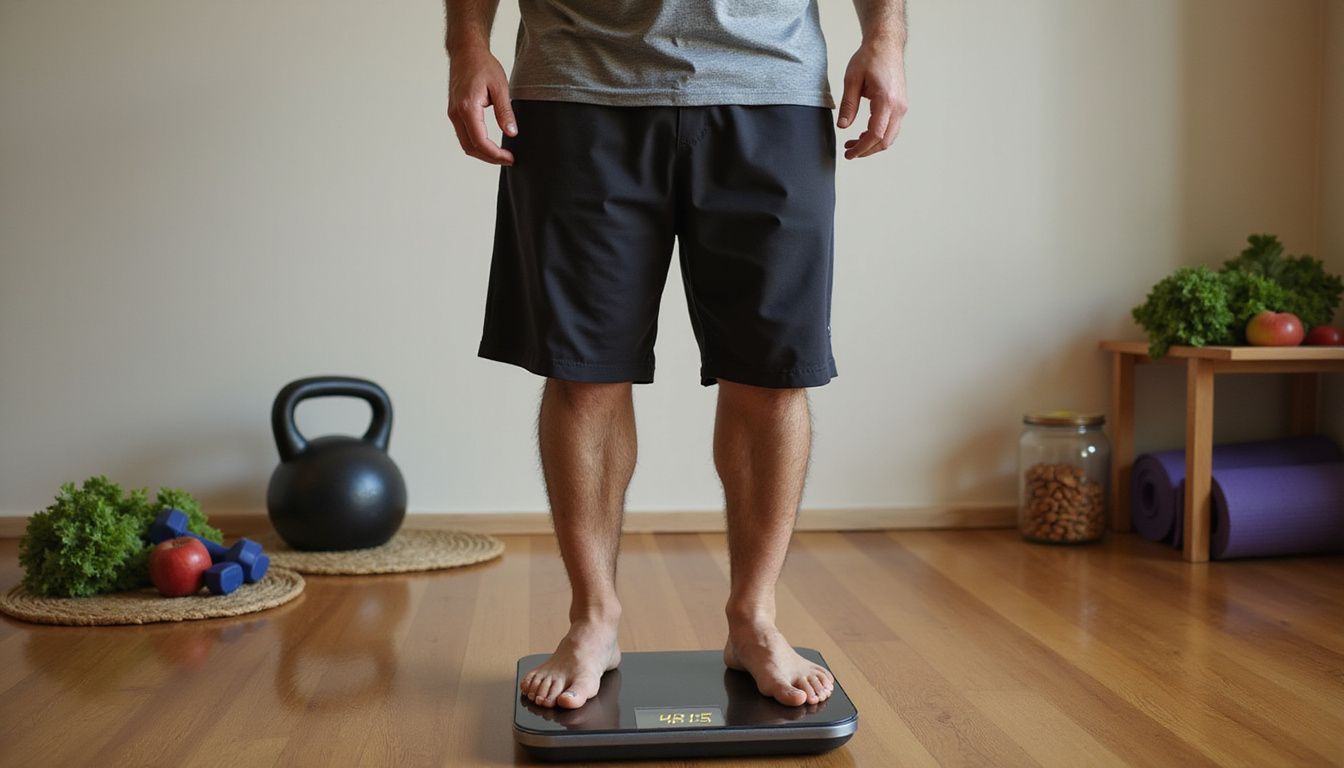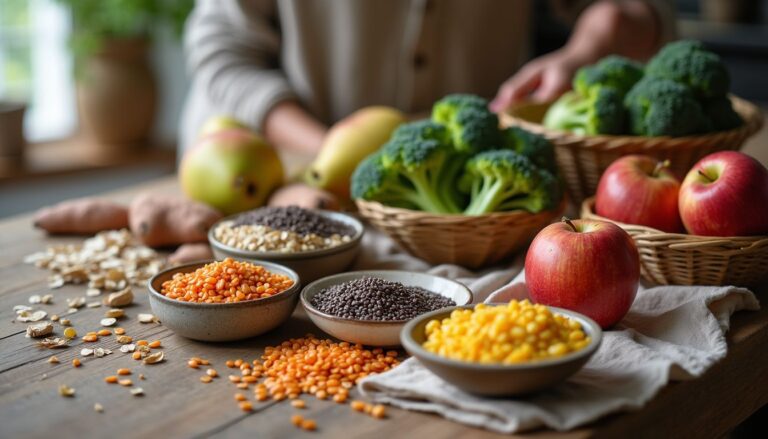Effective Weight Loss Diet Plan For Men: Meal Plan And Tips For Success
Our Nutrition Assistant AI Suite will transform your body. You will lose fat, get toned, and build muscle. Gain confidence and optimal health.
Frustrated that your current routine is not helping you lose fat? Many men face the same wall, often because the plan does not match their needs or lifestyle. A focused weight loss diet plan, paired with smart training, can change that.
This guide shows you how to build a practical meal plan, use healthy eating tips, and add the right amount of physical activity. You will learn what to eat, how much, and how to track progress without guesswork. Keep reading and take the next step toward a healthier you.
Key Takeaways
- Reduce daily intake by about 500 calories to lose roughly 1 pound per week safely.
- High protein, about 1.2 to 1.6 grams per kilogram of body weight, helps preserve muscle and supports metabolism.
- Choose complex carbohydrates and aim for 25 to 30 grams of fiber per day for fullness and better digestion.
- Combine strength training with at least 150 minutes of moderate cardio weekly for lasting fat loss.
- Track meals, manage portions, drink 8 to 10 cups of water daily, and limit processed foods for sustainable results.

Understanding Weight Loss for Men

Understanding how weight loss works helps you build a plan that lasts. Knowing how calories, metabolism, and food choices connect can also lower your risk for type 2 diabetes and heart disease.
What Is a Calorie Deficit and Why Is It Important?
A calorie deficit means you eat fewer calories than your body uses each day. This gap makes your body tap into stored fat for energy. Over time, that leads to steady fat loss and better weight management.
Many men maintain weight at 2,000 to 2,500 calories a day. Dropping about 500 calories per day usually leads to a 1 pound weekly loss. Very low intakes can slow metabolism and raise the risk of muscle loss, so aim for a moderate deficit.
Long-term success comes from habits like portion control and choosing foods low in added sugar and unhealthy fats. The Centers for Disease Control and Prevention notes that even modest weight loss can reduce the risk of type 2 diabetes, heart disease, and high blood pressure.
Simple swaps help. Choose water instead of soda. Load plates with vegetables and fruit. As one nutritionist says,
Successful weight loss is not about starving yourself; it’s about creating small changes that fit your lifestyle.
How Does Metabolism Affect Weight Loss?
Metabolism is how your body converts food into energy. Men with more muscle usually burn more calories at rest and during activity. Age, genetics, sleep, and hormones also affect your burn rate.
Muscle declines with age, so building or keeping it is key. Strength training can raise your metabolic rate slightly, helping you lose fat without losing as much muscle. Eating enough protein at each meal supports that process during a calorie deficit.
After I started tracking meals and added two strength sessions per week, the scale moved faster. A higher protein breakfast and swapping white rice for brown rice helped me stay full and consistent.
Research shows that people who follow a plan and lift regularly tend to maintain healthier weights. If you want results that last, align your eating and activity so they work together.
The next step is learning how to balance your diet and workouts in a clear, simple way.
How to Balance Diet and Physical Activity for Weight Loss
Create a calorie deficit through both sides, intake and output. Build meals around lean protein, high fiber, and healthy fats. Then schedule regular movement throughout the week.
Make small swaps. Use whole grain bread instead of white bread. Fill half your plate with vegetables. Aim for 30 minutes of brisk walking or cycling five days a week, which aligns with guidance from the Department of Health and Human Services.
Cut back on sugary drinks and heavily processed snacks to reduce calories a day without feeling deprived. Add protein such as chicken, fish, tofu, or Greek yogurt to support muscle recovery after exercise.
Using a nutrition and fitness app helped me keep calories, protein, and workouts on track. That structure supported steady fat loss, not just a short-term drop.
Next, explore the key components of an effective weight loss diet plan, including how much protein you need each day.
Key Components of an Effective Weight Loss Diet Plan
A sound diet plan for weight loss covers protein, healthy fats, complex carbohydrates, and fiber. These nutrients help you lose fat, protect muscle, and control hunger.
How Much Protein Should Men Eat for Weight Loss?
Protein protects lean muscle while you lose fat. Aim for 1.2 to 1.6 grams per kilogram of body weight daily. Spread protein across meals and snacks to steady appetite and support recovery.
If you weigh 80 kilograms, that means about 96 to 128 grams per day. Higher protein can improve fullness and curb cravings, which makes sticking to a calorie target easier.
Choose lean sources like chicken breast, turkey, fish, low fat dairy, tofu, and legumes. Include protein each time you eat rather than saving it all for one meal.
Plant options such as beans, lentils, and edamame bring both protein and fiber. Many men find starting the day with eggs or Greek yogurt makes it easier to hit their target before dinner.
What Are Healthy Fats and How to Include Them?
Healthy fats support your heart, hormones, and brain. Add olive oil, avocado, nuts, salmon, and seeds to your routine. These fats can lower inflammation and support a healthy blood pressure and body mass index.
Evidence shows that monounsaturated and polyunsaturated fats, found in nuts and fatty fish, are linked to lower rates of cardiovascular disease.
Easy ideas: drizzle olive oil on salad, add avocado to a turkey wrap, or snack on a small handful of almonds. I like a tablespoon of ground flaxseed in oatmeal for omega 3 fats.
Choosing healthy fats in place of butter or highly processed oils helps steady blood sugar and manage calories. Grilled salmon instead of beef adds omega 3s and keeps dinner lighter.
Carbohydrates also matter. Let’s look at how the right carbs support results.
Why Choose Complex Carbohydrates?
Complex carbohydrates digest slowly, so they provide steady energy. Whole grains like oats, brown rice, and whole grain corn cause a gentler rise in blood sugar compared to sweets or white bread.
This slower digestion helps control hunger. Diets rich in complex carbs are linked with better appetite control and easier weight management.
Reach for fiber rich foods such as beans, peas, berries, and bananas. Low glycemic choices can reduce rapid cravings and support stable portion sizes.
Complex carbs deliver B vitamins and minerals that support physical and mental health. Many men find these options align with the Dietary Guidelines for Americans while still supporting a calorie deficit.
How Does Fiber Help Digestion and Weight Loss?
Fiber is the part of plant foods that your body does not fully digest. Soluble fiber, found in oats, beans, and apples, forms a gel in your stomach. That slows digestion and increases fullness.
Insoluble fiber, found in whole grains, nuts, and vegetables, adds bulk to stool and helps prevent constipation. High fiber foods are usually lower in calories per bite, which makes it easier to eat less without feeling hungry.
Aim for 25 to 30 grams of fiber each day. Your gut will thank you, and your appetite will be easier to manage.
Sample Meal Plans for Effective Weight Loss
Structured meal plans can reduce guesswork. The options below balance protein, fiber, and healthy fats. They also show portions that support a calorie deficit without leaving you hungry.
What Does a 1500-Calorie Meal Plan Look Like?
A 1500 calorie plan can help many men start losing fat safely. Keep meals simple and build around lean protein, vegetables, and whole grains.
- Breakfast: one boiled egg, one slice of whole grain toast, and half an avocado. Choose black coffee or plain tea to avoid extra calories.
- Snack: a small apple or a handful of unsalted nuts to control sodium and support heart health.
- Lunch: grilled chicken or tofu with sautéed broccoli, carrots, and tomatoes. Add a small serving of brown rice or quinoa for fiber.
- Snack: low fat Greek yogurt or a small cheese stick. Protein helps you stay full until dinner.
- Dinner: grilled salmon, steamed vegetables, and mixed greens. Use olive oil and avoid heavy sauces.
- Hydration: drink water, herbal tea, or water with lemon. Limit sugary drinks and sweetened juices with added fructose.
- Sweet tooth: a small square of dark chocolate after dinner can fit your plan.
- Tracking: log meals in an app to stay near 1500 calories and spot patterns.
- Prep tip: simple recipes and a grocery list help you avoid last minute high calorie choices.
How to Follow an 1800-Calorie Meal Plan?
An 1800 calorie plan offers a little more food while still supporting weight loss. Focus on balance and portions so you meet your needs without overeating.
- Start with a balanced breakfast, such as eggs, whole grain toast, and fruit for steady energy.
- Include lean proteins at lunch and dinner, like chicken, turkey, fish, or tofu, to support muscle.
- Fill half your plate with non starchy vegetables, including broccoli, spinach, or peppers.
- Use complex carbs such as brown rice, oats, or quinoa. Keep added sugars low.
- Add healthy fats from nuts, seeds, avocado, or olive oil to reduce cravings.
- Track intake with an app or journal to stay near 1800 calories.
- Drink at least eight cups of water a day to support digestion and reduce snacking.
- Use smaller plates or measure servings to support portion control.
- Limit processed foods and scan labels for added sugars and unhealthy fats.
- Space meals every three to four hours to steady energy and avoid night overeating.
- If you have special health needs, consult a healthcare provider or nutritionist for a tailored plan.
What Is the 7-Day GM Diet Plan?
Some men try short, strict plans for fast results. The 7 Day GM Diet Plan is one example, though it focuses on rapid loss rather than long term habits.
- Created in the 1980s for an employee wellness program, it claims 10 to 17 pounds of weight loss in a week by rotating specific foods.
- Day 1: fruit only, except bananas. Choose water rich produce like melons and citrus.
- Day 2: vegetables only, including potatoes early in the day for energy.
- Day 3: mix fruits and vegetables, but avoid bananas and potatoes.
- Day 4: up to 8 bananas with skim milk to add potassium and protein.
- Day 5: lean meat or cottage cheese with six tomatoes. Vegetarians can use rice as a substitute.
- Day 6: beef with vegetables, or brown rice for vegetarians. Avoid potatoes.
- Day 7: brown rice, vegetables, and fruit juice without added sugar.
- Hydrate with at least eight glasses of water daily to protect kidneys and maintain energy.
- Many clinicians warn that very rapid loss can reduce muscle and limit nutrients. Use caution with repeat cycles.
- I tried it before a sport event and saw a quick drop on the scale, but my energy dipped by the end of the week. Talk with a clinician before making big changes.
Easy-to-Prepare Recipes for Men
Cooking at home gives you control over calories, salt, and portions. These quick recipes deliver protein, fiber, and flavor without complicated steps.
How to Make Chicken and Vegetable Stir-Fried Rice?
This stir fry balances protein, complex carbs, and healthy fats. It is a good post workout dinner that supports recovery and keeps you full.
- Cook 1 cup of brown rice in water or low sodium broth. Cool the rice for better texture in the pan.
- Cut one skinless chicken breast into bite size pieces for lean protein.
- Season with pepper and herbs. Keep added salt light.
- Heat 1 tablespoon olive oil in a nonstick pan over medium heat.
- Add chicken and cook 5 to 7 minutes until golden and cooked through.
- Add 1 cup chopped vegetables, such as broccoli, carrots, peas, and peppers.
- Stir fry for about 3 minutes. Keep veggies a little crisp for more nutrients.
- Add cooled rice and toss to combine.
- Season with 1 tablespoon low sodium soy sauce or tamari.
- Cook 2 more minutes. Ensure chicken reaches 165°F for safety.
- Top with a few chopped almonds or cashews for crunch and healthy fat.
I tried this after a cardio day and stayed full for hours. Using colorful vegetables and leftover rice made prep simple.
What Is a Broccoli Feta Omelet Recipe?
A Broccoli Feta Omelet is quick, satisfying, and fits most healthy eating plans. It offers protein, fiber, and a bit of healthy fat with only a few ingredients.
- Beat 2 large eggs in a bowl until combined.
- Chop 1/2 cup broccoli and steam for 3 to 4 minutes.
- Warm 1 teaspoon olive oil in a nonstick skillet over medium heat.
- Pour in eggs and let the edges set for about a minute.
- Add broccoli and 2 tablespoons crumbled feta.
- Cook until mostly set, then fold and slide onto a plate.
- Season with pepper or herbs like dill or parsley.
- Serve with a slice of whole grain toast or half an avocado.
- About 250 calories, with strong satiety that helps you maintain a calorie deficit.
- Feta provides flavor at a lower saturated fat level than many cheeses.
- Works in both a 1,500 or 1,800 calorie plan and supports metabolic health.
How to Prepare Quick Berry Oatmeal?
Berry oatmeal is a high fiber breakfast that curbs mid morning hunger. It is easy to batch for busy weekdays.
- Use rolled oats for more fiber. Measure 1/2 cup dry oats, about 150 calories.
- Add 1 cup water or low fat milk to a microwave safe bowl with the oats.
- Microwave 2 minutes, stir, then heat 1 more minute as needed.
- Add 1/2 cup berries, fresh or frozen, for antioxidants and vitamin C.
- Top with 1 tablespoon chia or ground flaxseed for omega 3s and extra fiber.
- Flavor with cinnamon or 1 teaspoon honey instead of sugar.
- Serve hot and notice fullness lasts longer.
- Use water to fit a 1,500 calorie plan or milk for an 1,800 calorie day.
How to Cook Grilled Salmon with Quinoa?
This meal delivers lean protein, omega 3 fats, and complex carbs. It supports heart health and recovery after training.
- Choose a 4 ounce salmon fillet per serving. It offers about 23 grams of protein.
- Preheat grill to medium high, around 400°F.
- Season with salt, pepper, and lemon.
- Grill skin side down 4 to 5 minutes. Flip and cook 3 to 4 minutes more until it flakes.
- Rinse 1 cup quinoa and cook in 2 cups water, simmer 12 to 15 minutes.
- Steam vegetables like broccoli or peppers for fiber and vitamins.
- Serve salmon over quinoa with a side of vegetables.
- Add a drizzle of olive oil or a sprinkle of feta for flavor.
- Drink water with the meal to support digestion and appetite control.
- If you have a history of heart attack or stroke, talk to your doctor about diet changes.
How to Make a Turkey and Avocado Wrap?
This wrap is fast, high in protein, and easy to meal prep. It travels well for lunch.
- Place a large whole grain tortilla on a board. Whole grains add fiber that supports fullness.
- Spread 2 tablespoons hummus or Greek yogurt for flavor and moisture.
- Add 3 to 4 ounces cooked turkey breast for lean protein.
- Layer half an avocado in slices for healthy monounsaturated fat.
- Top with 1 cup mixed greens and tomato slices for volume and nutrients.
- Roll tightly and slice in half.
- Eat now or wrap in foil for later. I often make two after a workout to save time.
This high protein option fits most weight loss plans, though it would not fit a strict carnivore diet.
Tips for Long-Term Weight Loss Success
Lasting weight loss comes from simple habits done daily. Use the strategies below to make progress feel easier and more consistent.
What Are Effective Portion Control Strategies?
Smaller plates help. People often eat about 30 percent less from a 9 inch plate compared to a 12 inch plate. Serve single portions instead of eating from bags or cartons.
Read labels to check serving sizes. Use measuring cups or a kitchen scale for items like rice, pasta, nuts, and oils. Pre portion snacks such as baby carrots or berries into small containers for grab and go choices.
Weighing my chicken before cooking showed me I was often eating double my target. Eating slowly also helps. Pause mid meal and check your fullness before going back for more.
Filling half your plate with vegetables keeps calories lower while boosting fiber and satisfaction. Many people find meal tracking apps make portion control easier over time.
How Much Water Should You Drink for Weight Loss?
Most men do well with 8 to 10 cups of water daily, or about 2 to 2.5 liters. If you train hard or sweat more, you may need extra. Drinking water before meals can help reduce calorie intake and support digestion.
Thirst can feel like hunger. Carry a bottle and sip during the day. Hydration supports metabolism and complements any meal plan for men.
Logging water in the same app you use for food can make this habit stick.
Why Reduce Processed Foods?
Processed foods often pack added sugar, unhealthy fats, and excess sodium. They add many calories with little fiber or nutrients.
In a 2019 Cell Metabolism study, people ate about 500 more calories per day on ultra processed diets compared with unprocessed diets. Higher intake is linked to weight gain, heart disease, and type 2 diabetes.
Choose whole foods like lean meat, fish, eggs, beans, fruit, vegetables, and whole grains. These foods are more filling per calorie because of their water and fiber content.
Swapping packaged snacks for fruit or a small handful of nuts steadied my energy during long afternoons.
How to Track Your Weight Loss Progress?
Use a digital scale two times a week at the same time of day. Log results in a journal or an app. Track waist and hip measurements every two to four weeks to see changes that the scale might miss.
Keep a food diary and note water intake. Photos of meals or progress pictures can add motivation. Set small milestones and celebrate each one.
Simple tracking helped me spot links between late night snacks and the next morning’s weigh in. That awareness made change easier.
What Is Mindful Eating and How to Practice It?
Mindful eating means paying attention to your food and your body’s signals. Focus on taste, texture, and smell. Eat slowly and chew thoroughly. Notice hunger at the start and fullness near the end.
Turn off screens and sit at a table. Take a few deep breaths before the first bite. Put your fork down between bites to slow the pace.
If you feel full, stop, even if there is food left. Mindful eating pairs well with portion control and can reduce overeating.
The Role of Exercise in a Weight Loss Plan
Exercise helps you burn calories and build muscle, which supports a higher metabolism. The right mix makes it easier to lose fat and keep it off.
Why Is Strength Training Important for Weight Loss?
Strength training helps you build and maintain muscle as you cut calories. More muscle increases the calories you burn at rest. Lifting weights can also raise your burn for hours after a workout.
Stronger muscles protect joints, reduce injury risk, and make daily tasks easier. Many men also find training improves confidence, which makes healthy eating easier to sustain.
Combined with a high fiber diet and adequate protein, strength work supports digestion, recovery, and long term weight management.
How to Incorporate Cardio Workouts Effectively?
Start with 150 minutes per week of moderate cardio like brisk walking, cycling, or swimming. Split sessions into 20 to 30 minutes as you build the habit.
High intensity interval training, or HIIT, alternates hard efforts with easy recovery to save time and raise calorie burn. For example, jog for one minute, then walk for one minute, repeat 10 times.
Pick activities you enjoy to stay consistent. Mix formats to prevent boredom. Drink water, and log workouts so you can see progress.
How to Balance Exercise and Recovery?
Schedule rest between heavy sessions. Muscles usually need at least 48 hours to recover after intense lifting. On recovery days, light walking or stretching improves blood flow and reduces soreness.
Sleep 7 to 8 hours per night to support hormones and muscle repair. Eat enough protein, complex carbs, and healthy fats. A fiber rich diet supports digestion while you recover.
Taking rest seriously helped me avoid nagging injuries and kept my training steady.
Next, review common mistakes that can slow progress.
Common Mistakes to Avoid
A few common errors can stall progress and harm health. Avoid the traps below to protect your results and your energy.
Why Is Over-Restricting Calories Harmful?
Eating too few calories can slow your metabolism and push your body to burn muscle. Men who drop below about 1,200 calories per day may miss key nutrients and feel tired or irritable.
Very low intake can also reduce testosterone and make muscle maintenance harder. I tried cutting below 1,200 once and felt sluggish, with more muscle loss than fat loss.
Extreme restriction often leads to rebound eating later. It can cause vitamin and mineral gaps that affect mood, immunity, and energy. A moderate calorie deficit is safer and far more sustainable.
What Happens When You Skip Meals?
Skipping meals can lower energy and trigger overeating later. Blood sugar may dip, leading to headaches, mood swings, and poor focus. Hunger hormones rise, and you might eat more at night.
Fiber intake also drops when meals are missed, which can slow digestion. I tried skipping lunch for a week and ended up with afternoon headaches and evening binges.
Studies have linked regular breakfast skipping with higher body fat in men. *Data: Harvard School of Public Health (2013), American Journal of Clinical Nutrition (2015).*
How to Maintain Nutritional Balance?
Balanced meals help you stay energized and reduce cravings. Include lean protein at every meal to support muscle. Use whole grains like brown rice or oats for steady energy.
Fill your plate with vegetables and fruit for vitamins and fiber. Add healthy fats from avocado, nuts, or olive oil to support brain function and hormones.
Track meals for a week to check protein, complex carbs, fiber, and healthy fat intake. I felt better once I added more vegetables and whole grains. A colorful plate usually means a better nutrient mix.
The Importance of Professional Guidance
Expert support helps you tailor your plan and avoid common mistakes. A short check in can save months of trial and error.
When Should You Consult a Nutritionist?
If weight is stuck despite consistent effort, a nutritionist can help. Unusual fatigue, swings in appetite, or digestive issues like irregular bowel movements are also signals to seek advice.
Men with diabetes, high cholesterol, or high blood pressure need a plan that supports their condition. A nutritionist can guide protein, fat, carbohydrate, and fiber choices to fit your goals and medical needs.
I reached out after a long plateau and learned my portions were too large for my activity. Small changes to meal timing and fiber intake made a quick difference.
How Can Fitness Trainers Support Your Weight Loss?
Trainers design workouts that match your level and goals. They teach proper form, which lowers injury risk, and help you progress safely.
With a trainer, you get accountability and structure. Programs often blend strength work with cardio to boost calorie burn and preserve muscle.
Many trainers also discuss basic nutrition habits, like hitting protein targets and spacing meals. Their check ins make it easier to stay consistent.
Frequently Asked Questions
Below are answers to common questions that come up during a weight loss journey. Use them to guide your own plan for men.
How Much Weight Can I Lose in a Month?
A safe target is 4 to 8 pounds per month for most men. That equals roughly 1 to 2 pounds per week, which aligns with CDC guidance.
Create a daily deficit of 500 to 1,000 calories through eating and activity. Faster loss is harder to maintain and may hurt your health.
Slow and steady worked best for me. Focus on protein, fiber, healthy fats, and regular movement for results that last.
Is Intermittent Fasting Effective for Men?
Intermittent fasting, or IF, limits eating to a set window each day. Some studies show men can lose fat while maintaining muscle with IF.
One 2020 trial found that an 8 hour eating window led to about 3 percent body weight loss in 12 weeks without loss of lean tissue. Many find IF easier than counting calories, but food quality still matters.
I used a noon to 8 p.m. window for three months, focusing on protein and vegetables. Energy felt steady, but I had to plan meals carefully to meet nutrient needs. Speak with your doctor first if you have medical conditions or take medication.
What Are the Best Snacks for Weight Loss?
Choose snacks with protein and fiber. Good options include Greek yogurt with berries, mixed nuts, or sliced vegetables with hummus.
Per the USDA, a serving of almonds, about 23 nuts, provides around 6 grams of protein and 4 grams of fiber for about 164 calories. Air popped popcorn offers about 30 calories per cup and satisfies a crunchy craving.
Fresh fruit like apples or oranges adds fiber and vitamins. Hard boiled eggs pack about 6 grams of protein for roughly 70 calories. Keep portions in check so snacks fit your daily plan.
Conclusion
Reaching your goals starts with a clear weight loss diet plan and repeatable habits. Build balanced meals, track calories, and train with both strength and cardio. Protein, healthy fats, complex carbs, and fiber are the anchors.
Use meal prep, portion control, and mindful eating to make daily wins easier. Drink enough water and limit processed foods. Track progress weekly and get professional help when you need it.
This approach supports sustainable weight loss and better health. If you have a medical condition, consult a healthcare professional before major diet or exercise changes.
Sources: Centers for Disease Control and Prevention, Weight Management; U.S. Department of Health and Human Services, Physical Activity Guidelines; Hall et al., Cell Metabolism, 2019; Harvard School of Public Health, 2013; American Journal of Clinical Nutrition, 2015.
FAQs
1. What is an effective weight loss diet plan for men?
An effective weight loss diet plan for men focuses on nutrient-rich foods, portion control, and balanced meals. Research shows that eating lean proteins, whole grains, fruits, and vegetables supports fat loss and muscle retention. A sample meal plan may include oatmeal with berries for breakfast, grilled chicken salad for lunch, and baked fish with steamed vegetables for dinner. Studies suggest that men who track calories and maintain a daily deficit of 500 to 750 calories can lose about one to two pounds per week.
2. How important is protein in a weight loss meal plan for men?
Protein is vital for weight loss because it helps preserve muscle mass while reducing body fat. Clinical studies indicate that diets higher in protein can increase satiety and boost metabolism. For example, including eggs or Greek yogurt at breakfast can help control hunger throughout the day. Most experts recommend at least 0.8 grams of protein per pound of body weight during weight loss.
3. Are there specific tips to help men succeed with a weight loss diet?
Key tips include planning meals ahead of time, drinking plenty of water, and limiting processed foods. Research highlights the benefits of regular meal timing and mindful eating to avoid overeating. My own experience showed that preparing meals on Sundays made it easier to stick to healthy choices during busy work weeks.
4. What role do exercise and lifestyle habits play in a weight loss diet plan for men?
Exercise supports weight loss by increasing calorie burn and improving overall health. Combining strength training with aerobic activity helps maintain muscle while losing fat. Data from the Centers for Disease Control and Prevention show that adults should aim for at least 150 minutes of moderate exercise each week. Good sleep and stress management also contribute to better results.
Summary: A successful weight loss diet plan for men includes balanced meals rich in protein, careful meal planning, regular exercise, and healthy lifestyle habits. These strategies help achieve steady fat loss while supporting long-term health.







